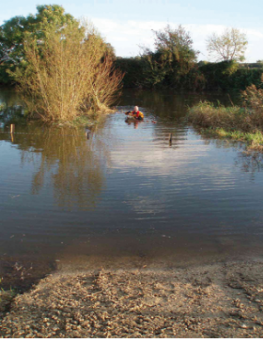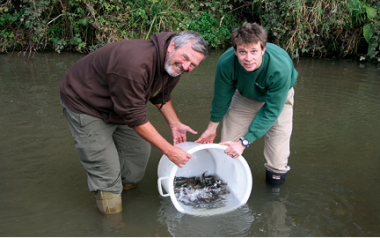You are here
Improving Fish Stocks On The Middle Dorset Stour
Historically the Dorset Stour between Blandford Forum and Wimborne Minster has provided a highly valued coarse fishery. However in recent years catches have fallen dramatically and poor fish recruitment has been detected by the Environment Agency’s monitoring teams. This has led to local angling clubs, Landowners, the Barbel Society and the Environment Agency to work together to develop a strategy to improve the resident fish stocks. This strategy has developed into a two pronged approach. The first is to address the reduction in key fish habitats and the second is to re-introduce fish species that otherwise would have little scope for returning naturally.
Habitat improvement works
In the past, flood risk management dredging of the River Stour removed vital habitat features and in high flows created deep, fast channels rather than allowing the river to dissipate its energy across the flood plain. The result was fish spawning habitat has been reduced and that young coarse fish survived poorly during high flows, as they were unable to find refuge in slack water areas.
In consultation with the National Trust, Test Valley Angling Club, Southampton Piscatorial Society and other interested parties the Environment Agency has, for a number of years, been carrying out a wide range of habitat enhancement projects in order to ameliorate the effects of the dredging and provide protection for the fry. Works over the last 2 years have been carried out on the stretch between Eye Bridge, Wimborne and Crawford Bridge, Spettisbury.

Habitat improvement techniques involve re-introducing gravel shallows and creating refuge areas for fish at times of high flow. Projects range from simply digging out a side channel to introducing many tonnes of gravel and rock into the river. Each potential habitat improvement site is assessed to determine the best technique to achieve the required aims of that site and all are assessed to ensure they do not increase the flood risk.
The ultimate aim of these on-going works is to achieve a diverse range of habitat types that fulfil the needs for the fish species present in that locality and generate an environment that ensures fish populations are sustainable and resilient.
Re-establishing the barbel population
The original introductions of barbel to the Avon and Stour river systems occurred in the early 1900s where they quickly established self sustaining populations. The Environment Agency’s historical monitoring results for the Stour indicate that barbel had reached a good level of abundance as far as upstream as Blandford by the end of the 1970s and with their numbers peaking in the early 1980s. However, they have since declined to sporadic pockets of fish in the Blandford to Wimborne reach.
The significant factors causing this decline are considered to be the dredging of this part of the Stour in the early 80s and fish kills associated with pollution incidents.
The habitat improvement works carried out by the Environment Agency, the natural processes of the river and improved environmental legislation aimed at reducing pollution incidents should now provide suitable habitat for barbel once again.
To kick start their recovery the Barbel Society, together with the Environment Agency has implemented a three-year stocking programme with 3000, one year old barbel being stocked annually into three locations in this reach. The aim of this is to establish a solid base from which a self sustaining population can be built.

The barbel have all been provided by the Environment Agency’s Calverton Fish Farm and range in size from 10cm to 20cm. Each of the fish stocked has been marked with a coloured elastomer resin on their head. The colour and location of the mark corresponds to the time and place stocked so that when these fish are caught in the future we can identify where they were stocked and how well the fish are doing. The marking of the barbel has been jointly funded by the Barbel Society and the Environment Agency.
It is hoped that anglers and angling clubs will report all barbel catches to the Agency - so if you catch a barbel on the Stour – look out for a bright splash of colour, about 2 – 3 millimetres long, near the eye. Please note the colour, the position of the tag, the river location of capture and an estimate of the size of the fish - and report your catch to the FRB team, Environment Agency, Rivers House, Sunrise Business Park, Blandford DT11 8ST Telephone 01258483454.
Your help will be greatly appreciated.
Environment Agency, Wessex Area
